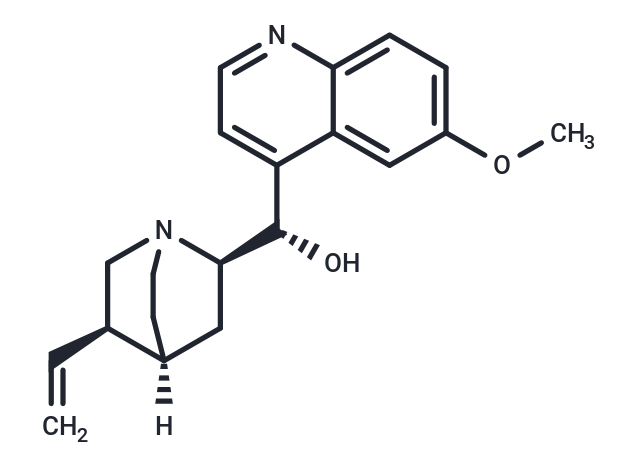Shopping Cart
Remove All Your shopping cart is currently empty
Your shopping cart is currently empty
Quinidine is a stereoisomer of the antimalarial agent quinine and a class Ia antiarrhythmic agent. for the treatment of abnormal heart rhythms and also malaria.

| Pack Size | Price | USA Warehouse | Global Warehouse | Quantity |
|---|---|---|---|---|
| 50 mg | $30 | - | In Stock | |
| 100 mg | $42 | Inquiry | Inquiry | |
| 200 mg | $55 | Inquiry | Inquiry | |
| 1 mL x 10 mM (in DMSO) | $39 | In Stock | In Stock |
| Description | Quinidine is a stereoisomer of the antimalarial agent quinine and a class Ia antiarrhythmic agent. for the treatment of abnormal heart rhythms and also malaria. |
| In vitro | Quinidine blocks the voltage-gated sodium (Nav) channel Nav1.5 in a use-dependent manner.It decreases the amplitude and duration of action potentials in isolated canine ventricular myocytes[1]. |
| Molecular Weight | 324.42 |
| Formula | C20H24N2O2 |
| Cas No. | 56-54-2 |
| Smiles | [H][C@@]12CCN(C[C@@H]1C=C)[C@H](C2)[C@@H](O)c1ccnc2ccc(OC)cc12 |
| Relative Density. | 1.1294 g/cm3 (Estimated) |
| Color | White |
| Appearance | Solid |
| Storage | keep away from direct sunlight | Powder: -20°C for 3 years | In solvent: -80°C for 1 year | Shipping with blue ice/Shipping at ambient temperature. | |||||||||||||||||||||||||||||||||||
| Solubility Information | DMSO: 50 mg/mL (154.12 mM), Sonication is recommended. | |||||||||||||||||||||||||||||||||||
| In Vivo Formulation | 10% DMSO+40% PEG300+5% Tween 80+45% Saline: 2 mg/mL (6.16 mM), Sonication is recommended. Please add the solvents sequentially, clarifying the solution as much as possible before adding the next one. Dissolve by heating and/or sonication if necessary. Working solution is recommended to be prepared and used immediately. The formulation provided above is for reference purposes only. In vivo formulations may vary and should be modified based on specific experimental conditions. | |||||||||||||||||||||||||||||||||||
Solution Preparation Table | ||||||||||||||||||||||||||||||||||||
DMSO
| ||||||||||||||||||||||||||||||||||||
| Size | Quantity | Unit Price | Amount | Operation |
|---|

Copyright © 2015-2026 TargetMol Chemicals Inc. All Rights Reserved.